PARP1 Regulates Circular RNA Biogenesis though Control of Transcriptional Dynamics
- PMID: 37190069
- PMCID: PMC10136798
- DOI: 10.3390/cells12081160
PARP1 Regulates Circular RNA Biogenesis though Control of Transcriptional Dynamics
Abstract
Circular RNAs (circRNAs) are a recently discovered class of RNAs derived from protein-coding genes that have important biological and pathological roles. They are formed through backsplicing during co-transcriptional alternative splicing; however, the unified mechanism that accounts for backsplicing decisions remains unclear. Factors that regulate the transcriptional timing and spatial organization of pre-mRNA, including RNAPII kinetics, the availability of splicing factors, and features of gene architecture, have been shown to influence backsplicing decisions. Poly (ADP-ribose) polymerase I (PARP1) regulates alternative splicing through both its presence on chromatin as well as its PARylation activity. However, no studies have investigated PARP1's possible role in regulating circRNA biogenesis. Here, we hypothesized that PARP1's role in splicing extends to circRNA biogenesis. Our results identify many unique circRNAs in PARP1 depletion and PARylation-inhibited conditions compared to the wild type. We found that while all genes producing circRNAs share gene architecture features common to circRNA host genes, genes producing circRNAs in PARP1 knockdown conditions had longer upstream introns than downstream introns, whereas flanking introns in wild type host genes were symmetrical. Interestingly, we found that the behavior of PARP1 in regulating RNAPII pausing is distinct between these two classes of host genes. We conclude that the PARP1 pausing of RNAPII works within the context of gene architecture to regulate transcriptional kinetics, and therefore circRNA biogenesis. Furthermore, this regulation of PARP1 within host genes acts to fine tune their transcriptional output with implications in gene function.
Keywords: RNA polymerase II elongation and pausing; backsplicing; circRNAs; gene architecture; poly (ADP-ribose) polymerase; splicing; transcription elongation.
Conflict of interest statement
The authors declare no conflict of interest. The funders had no role in the design of the study; in the collection, analyses, or interpretation of data; in the writing of the manuscript; or in the decision to publish the results.
Figures
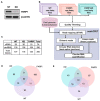
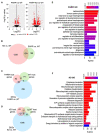
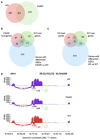


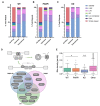

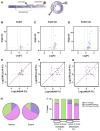
Similar articles
-
Exploring the interplay between PARP1 and circRNA biogenesis and function.Wiley Interdiscip Rev RNA. 2023 Nov 13:e1823. doi: 10.1002/wrna.1823. Online ahead of print. Wiley Interdiscip Rev RNA. 2023. PMID: 37957925 Free PMC article. Review.
-
Coupling of PARP1-mediated chromatin structural changes to transcriptional RNA polymerase II elongation and cotranscriptional splicing.Epigenetics Chromatin. 2019 Feb 18;12(1):15. doi: 10.1186/s13072-019-0261-1. Epigenetics Chromatin. 2019. PMID: 30777121 Free PMC article.
-
PARP1's Involvement in RNA Polymerase II Elongation: Pausing and Releasing Regulation through the Integrator and Super Elongation Complex.Cells. 2022 Oct 12;11(20):3202. doi: 10.3390/cells11203202. Cells. 2022. PMID: 36291070 Free PMC article.
-
Insights into the biogenesis and potential functions of exonic circular RNA.Sci Rep. 2019 Feb 14;9(1):2048. doi: 10.1038/s41598-018-37037-0. Sci Rep. 2019. PMID: 30765711 Free PMC article.
-
The multifaceted role of PARP1 in RNA biogenesis.Wiley Interdiscip Rev RNA. 2021 Mar;12(2):e1617. doi: 10.1002/wrna.1617. Epub 2020 Jul 12. Wiley Interdiscip Rev RNA. 2021. PMID: 32656996 Free PMC article. Review.
Cited by
-
Exploring the interplay between PARP1 and circRNA biogenesis and function.Wiley Interdiscip Rev RNA. 2023 Nov 13:e1823. doi: 10.1002/wrna.1823. Online ahead of print. Wiley Interdiscip Rev RNA. 2023. PMID: 37957925 Free PMC article. Review.
-
The dynamic process of covalent and non-covalent PARylation in the maintenance of genome integrity: a focus on PARP inhibitors.NAR Cancer. 2023 Aug 21;5(3):zcad043. doi: 10.1093/narcan/zcad043. eCollection 2023 Sep. NAR Cancer. 2023. PMID: 37609662 Free PMC article.
-
Multifaceted Role of PARP1 in Maintaining Genome Stability Through Its Binding to Alternative DNA Structures.J Mol Biol. 2024 Jan 1;436(1):168207. doi: 10.1016/j.jmb.2023.168207. Epub 2023 Jul 20. J Mol Biol. 2024. PMID: 37481154 Free PMC article. Review.
-
Circular RNAs Variously Participate in Coronary Atherogenesis.Curr Issues Mol Biol. 2023 Aug 13;45(8):6682-6700. doi: 10.3390/cimb45080422. Curr Issues Mol Biol. 2023. PMID: 37623241 Free PMC article. Review.
References
Publication types
MeSH terms
Substances
Grants and funding
LinkOut - more resources
Full Text Sources
Molecular Biology Databases
Miscellaneous

